
About UsThe Numismatic Bibliomania Society is a non-profit organization promoting numismatic literature. For more information please see our web site at coinbooks.org SubscriptionsThose wishing to become new E-Sylum subscribers (or wishing to Unsubscribe) can go to the following web page link MembershipThere is a membership application available on the web site Membership Application To join, print the application and return it with your check to the address printed on the application. Membership is only $15 to addresses in the U.S., $20 for First Class mail, and $25 elsewhere. For those without web access, write to: David M. Sundman, Secretary/TreasurerNumismatic Bibliomania
Society AsylumFor Asylum mailing address changes and other membership questions, contact David at this email address: dsundman@LittletonCoin.com SubmissionsTo submit items for publication in The E-Sylum, just Reply to this message, or write to the Editor at this address: whomren@coinlibrary.com
BUY THE BOOK BEFORE THE COINYou won't regret it! |
- WAYNE'S WORDS: THE E-SYLUM MAY 10, 2009
- SKLOW NUMISMATIC LITERATURE SALE #7 CATALOG AVAILABLE
- NEW BOOK: A REGISTER OF LIBERTY SEATED HALF DOLLAR DIE VARIETIES
- REPRINT: NEW ORLEANS MINT PAMPHLET: HOW MONEY IS COINED
- NEW BOOK: GUIDE BOOK OF FLYING EAGLE AND INDIAN HEAD CENTS BY RICK SNOW
- NEW BOOK: LARGE PRINT EDITION OF THE 2010 "RED BOOK"
- BOOKS ON ONTARIO TOKENS AND MEDALS
- BOLING COMMENTS ON RECENT BOOK REVIEWS
- PRESIDENTIAL 79TH SALE CATALOG AVAILABLE
- NEW BOOK: THE QUARTERMASTER COLLECTION OF RARE AUSTRALIAN GOLD
- MASSACHUSETTS HISTORICAL SOCIETY PUBLICATIONS NOW ONLINE
- COLUMN: HARVEY STACK REMEMBERS
- QUERY: SALATHIEL ELLIS PORTRAITS, CAMEOS SOUGHT
- QUERY: NAME THE BIBLIOPHILE ON THIS FRANKLIN MINT MEDAL
- QUERY: JOHN J. FORD COLLECTION: SOLD AND UNSOLD
- MORE ON JOSEPH JENKS
- MORE ON THE SCHULMAN-HOLZER COIN COLLECTORS' ALMANAC
- MORE ON CANADIAN ELONGATED CENTS
- AMAZON'S KINDLE E-BOOK READER GAINING FAST; NEW LARGE-SCREEN COMING
- MORE ON THE YOACHUM SILVER DOLLAR
- SOME HAUNTING BOOK-SCULPTURES
- QUEEN’S TRINITY CROSS MEDAL DEEMED UNLAWFUL
- MORE ON THE REALISTIC VIETNAMESE PLAY MONEY
- TREASURY DEPARTMENT ISSUES RECALL OF ALL US DOLLARS
- FEATURED WEB SITE: WORLDCAT
WAYNE'S WORDS: THE E-SYLUM MAY 10, 2009
 Among our recent subscribers are Ans ter Woerds of the Netherlands, and Karl Burgess. We now have 1,224 subscribers.
Among our recent subscribers are Ans ter Woerds of the Netherlands, and Karl Burgess. We now have 1,224 subscribers. This week we open with an update from literature dealer David Sklow and information on several new books and reprints in the numismatic field. We also look at two important new auction catalogs. Queries this week involve Salathiel Ellis, and a new mystery bibliophile.
Topics continuing from previous issues include Joseph Jenks, the John J. Ford collection, Hans Holzer, and Vietnamese play money. To learn about the recall of all U.S. paper money, read on. Have a great week, everyone!
Wayne Homren
Numismatic Bibliomania Society
SKLOW NUMISMATIC LITERATURE SALE #7 CATALOG AVAILABLE
 On June 13, 2009, David Sklow-Fine Numismatic Books will close their 7th auction. Catalogs available by request; Send inquiries to: David Sklow-Fine Numismatic Books, P. O. Box 6321, Colorado Springs, CO 80934. Telephone: (719)-302-5686; Fax: (719)-302-4933; Email: numismaticbooks@aol.com.
On June 13, 2009, David Sklow-Fine Numismatic Books will close their 7th auction. Catalogs available by request; Send inquiries to: David Sklow-Fine Numismatic Books, P. O. Box 6321, Colorado Springs, CO 80934. Telephone: (719)-302-5686; Fax: (719)-302-4933; Email: numismaticbooks@aol.com. The catalog is in the mail and currently accessible on-line: www.finenumismaticbooks.com Bids will be accepted by, telephone, fax, email and regular mail.
Several sale highlights: The Estate Numismatic Library of a Connecticut Bibliophile; Myron Xenos Personal Library of United States Copper Related Literature; The Personal Library of a Former Numismatic Literature Publisher and Dealer; Memorabilia From Laurese Katen; Several other Consignments;
NEW BOOK: A REGISTER OF LIBERTY SEATED HALF DOLLAR DIE VARIETIES
 The purpose of my new book is four-fold:
The purpose of my new book is four-fold:- To document all the currently known Liberty Seated half dollars die marriages produced at the San Francisco Branch Mint
- To assist the beginning or advanced Liberty Seated half dollar collector into expanding beyond type, date, or date/mint collecting into die marriage collecting
- To aid the casual collector or dealer with proper variety identification and other pertinent information
- To establish a standard nomenclature for the Liberty Seated half dollar die marriages.
Previously, The Complete Guide to Liberty Seated Half Dollars listed a finite and pre-determined number of the most easily identifiable die varieties of the series. This new book is different and individually documents the San Francisco Branch Mint Liberty Seated Half Dollar die marriages of the obverse, reverse, and collar dies currently known.
It is commonly misunderstood by many collectors and dealers that the Liberty Seated denominations have been studied as extensively as the older copper and bust series, where the discovery of new die marriages is rare. This is far from reality.
The older copper and bust series have been extensively collected, exhaustively studied, and completely documented for many decades. The Liberty Seated series are far behind in that respect and have a lot of catching up to do. I hope to help that along for the half dollars.
The book details all 228 known San Francisco Branch Mint Liberty Seated Half Dollar die marriages with narratives, photos of diagnostics, rarity ratings, background information, etc.
- Includes nearly 1,400 photographs
- 313 pages in 8.5 by 11 inch size
- Printed on high quality 100# anthem gloss paper
- Available in 3-hole punched format (ready for your binder) or plastic comb binding format
- $45 plus $5 postage (Specify which format you desire)
Shipment date is late-May 2009. Order directly from the author at
Bill Bugert
1230 Red Rock Road
Gettysburg, PA 17325
REPRINT: NEW ORLEANS MINT PAMPHLET: HOW MONEY IS COINED
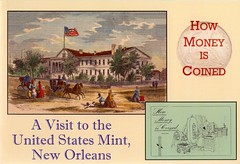 In 1897 author E.S. Gardiner spent some weeks at the New Orleans Mint. Gardiner took a series of photographs illustrating key aspects of the coining process and later that year published a comprehensive illustrated 30 page guidebook titled, How Money is Coined: A Visit in the United States Mint, New Orleans. It sold for 25 cents.
In 1897 author E.S. Gardiner spent some weeks at the New Orleans Mint. Gardiner took a series of photographs illustrating key aspects of the coining process and later that year published a comprehensive illustrated 30 page guidebook titled, How Money is Coined: A Visit in the United States Mint, New Orleans. It sold for 25 cents.This booklet is excessively rare - I've never seen one. The Centre for Louisiana Studies has used an early negative photographic copy of one of the booklets, originally owned by a woman working in the Mint's adjusting department, to reprint the booklet in full. It comes complete with an introduction by Greg Lambousy, Director of Collections at the Museum.
Those wishing to purchase a copy should contact: Centre for Louisiana Studies, Dupré Library, P.O. Box 40831, Lafayette, LA 70504, or email cls@louisiana.edu. The cost is $8 plus shipping.
To read the earlier E-Sylum article, see: HOW MONEY IS COINED: RARE NEW ORLEANS MINT PAMPHLET TO BE REPRINTED (http://www.coinbooks.org/esylum_v12n05a08.html)
NEW BOOK: GUIDE BOOK OF FLYING EAGLE AND INDIAN HEAD CENTS BY RICK SNOW
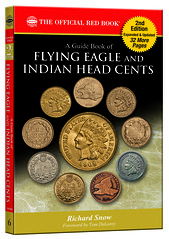 Guide Book of Flying Eagle and Indian Head Cents. The full-color, 288-page book has 32 more pages than the 1st edition, updating pricing and other market data, new photographs and other content, and new appendices. It is available nationwide for $19.95.
Guide Book of Flying Eagle and Indian Head Cents. The full-color, 288-page book has 32 more pages than the 1st edition, updating pricing and other market data, new photographs and other content, and new appendices. It is available nationwide for $19.95.As Q. David Bowers notes in the introduction, Flying Eagle and Indian Head cents, minted from 1856 to 1909, were once the most popular, most widely circulated, most plentiful coins in everyday American life. Several of them could buy a newspaper, or candy, or a streetcar ride. “Indian Head cents,” says Bowers, “were anywhere and everywhere.”
Now, in the 2nd edition of A Guide Book of Flying Eagle and Indian Head Cents, award-winning author Rick Snow examines these beautiful coins by date, mintage, production, survivability, collecting challenges, and variety. His research is bolstered by the usual high-quality Whitman treatment: an engaging overview of the series by the “dean of American numismatics,” Q. David Bowers; high-quality photographs in full color; expert advice on collecting; market values in multiple grades, including Red, Red/Brown, and Brown Mint States, as well as Proofs; certified population data; and a wealth of background information.
The expanded 2nd edition includes an illustrated biography of coin designer James B. Longacre; an appendix on detecting counterfeit and altered coins; an appendix of recent auction records, by date and variety; a history of market prices going back to 1946; and a bibliography for further research—plus new sections on pattern coins and toned Proofs.
A Guide Book of Flying Eagle and Indian Head Cents, 2nd edition, is available through online retailers and in bookstores nationwide. It can be ordered directly from Whitman at www.WhitmanBooks.com.
A Guide Book of Flying Eagle and Indian Head Cents, 2nd edition
By Richard Snow. Foreword by Tom DeLorey. Introduction by Q. David Bowers.
ISBN 0794828310
288 pages, softcover, 6 x 9 inches, full color
Retail $19.95
NEW BOOK: LARGE PRINT EDITION OF THE 2010 "RED BOOK"
“The new Large Print Edition Red Book is 45% larger than the regular edition,” said Whitman publisher Dennis Tucker. “It has bold, easy-to-read print, and every photograph is enlarged in high detail. The book includes all the content of the regular edition—every price, mintage, and specification, and all the historical background text.”
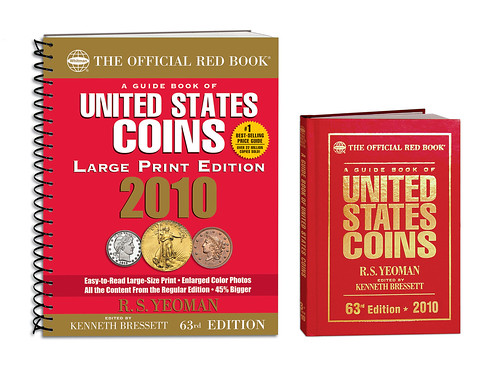
Known among collectors as the “Red Book,” the Guide Book is the world’s most popular annual retail price guide for U.S. coins, tokens, and other numismatic items. More than 22 million copies of the Red Book have been purchased since 1946, making it one of the best-selling nonfiction titles in the history of U.S. publishing.
For the 63rd edition, more than 140 professional coin dealers, scholars, and other numismatic experts contributed their knowledge under the direction of editor Kenneth Bressett, valuations editor Jeff Garrett, and research editor Q. David Bowers.
BOOKS ON ONTARIO TOKENS AND MEDALS
Numismatically Elgin, Numismatically Oxford, Numismatically Middlesex, Numismatically Norfolk and Numismatically Perth. Each of these books covers various businesses in the county covered and the tokens or medals they used. A brief history of the businesses and a description of the tokens used by them along with illustrations of the tokens and some of the stores is in each edition.
Numismatically Elgin is currently out of print but should be available shortly. The cost of the books are $15 plus $4 postage for Elgin, Oxford and Middlesex and $18 plus $4 postage for Norfolk and Perth.
I am currently working on a book for Waterloo County as well as Essex County. I am not expecting that either will be ready in the very near future. I also hope to begin on Brant County some time soon.
Our 98th mail-bid sale of numismatic literature features
selections from the library of Valerie Renee Nickles
(and other consignors)
- Lot A22 - McCawley & Grellman - Scott Barnes Sale - hardbound in leather and numbered.
- Lot C10 - Q. David Bowers' American Coin Treasures and Hoards - signed by QDB and inscribed by John J. Ford, Jr.
- Lot C31 - Ivy Press - 1990 - the two-part interview with John J. Ford, Jr. - Ford has written a rather caustic inscription relating to his situation vis-a-vis Territorial Gold, etc. Both issues are signed.
- C34 - Alan Kessler - 1976 - The Fugio Cents
- E15 - D. R. Cooper - 1988 - The Art and Craft of Coinmaking.....
- E42 - G. Michailovitch - 1973 (reprint) - Monnaies de L'Empire de Russie:1725-1894
- F55 - W. Wolka - 2004 - Nineteenth Century Ohio Obsolete Bank Notes and Scrip
- H89 - J. R. Snowden - 1861- ......Medals of Washington........
- J18 - C. S. Brigham - 1969 - Engravings of Paul Revere
BOLING COMMENTS ON RECENT BOOK REVIEWS
Last week I reviewed the new 2nd edition of Numismatic Photography by Mark Goodman. Joe Boling writes: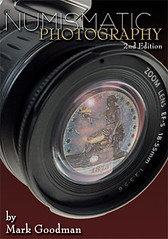
I also published a review by Joe Benice of Kansas Paper Money: An Illustrated History, 1854-1935 by Steve Whitfield. Regarding this book Joe Boling adds:
PRESIDENTIAL 79TH SALE CATALOG AVAILABLE
The catalog contains 224 pages featuring a whopping 1697 lots plus a fixed price section of official Barack Obama inaugural medals. One of the featured consignments is a selection of medals from the estate of William Merritt Chase, one of the most highly respected American artists of the late nineteenth century.
Other sections of the catalog cover a number of items we've discussed in The E-Sylum, including American Numismatic Society Medals and Medallic Ash Trays. -Editor
Lot 23 ALGERNON SYDNEY SULLIVAN BOOK AND MEDAL, 1911. 60 x 80mm. Bronze. J. E. Roine, Sc. Unc. Obverse with Sullivan’s portrait to the left. Inscribed above: IN HONOR OF/ ALGERNON SYDNEY SULLIVAN/ 1826 1887. In the exergue: HE REACHED OUT BOTH HANDS IN CONSTANT/ HELPFULNESS TO HIS FELLOW MEN. The reverse bears a depiction of Sullivan, as an older man, reaching out to aid a youth and with his flaming torch, lighting the torch of the youth. The inscription in the exergue is a quotation from Lowell: AS ONE LAMP LIGHTS ANOTHER, NOR GROWS LESS/ SO NOBLENESS ENKINDLITH NOBLENESS.
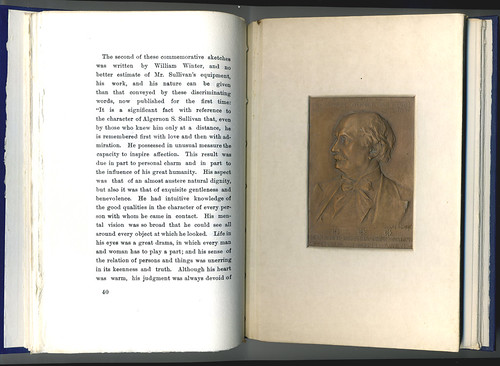
The medal has been solidly inserted in the middle of a hardbound book recounting the life of Mr. Sullivan who was a prominent lawyer and numismatist in New York City. The book informs us that the medal “... is awarded each year to the five persons who stand highest in their examinations for admission to the Bar of the State of New York.” and is presented by the American Numismatic Society. A key piece for the collector of book encased medals. (
Lot 44 AMERICAN RED CROSS, 1919. Baxter 327; Marqusee 176. 70.4mm. Bronze. Daniel Chester French, Sc. Unnumbered (MACO). A nice Uncirculated example of this popular medal. Obverse bust left of a World War I soldier in uniform and helmet. The reverse bears a scene of a nurse attending a prone patient within a depressed inner cross. THE AMERICAN RED CROSS around the upper border. Issued by the ANS. Along with the British and French War Commission medal, Barbara Baxter considers this medal as one of French’s two most outstanding pieces.
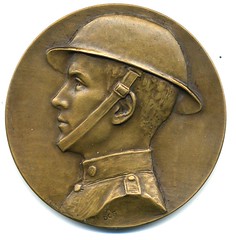
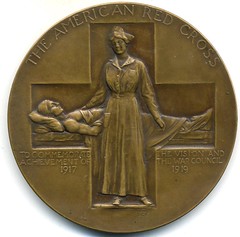
Scudder left Terre Haute in 1887 and enrolled at the Cincinnati Art Academy, receiving instruction under sculptor Louis Rebisso. It was here she also changed her name to Janet after a registrar informed her that Netta was not a real name.
Moving to Chicago three years later her talent earned her a place in the studio of Lorado Taft who utilized her on the sculptural decorations for the World’s Columbian Exposition. She became part of a group of women sculptors working under Taft that are now immortalized as the “White Rabbits.” She also received the commission to create statues to adorn the Illinois and Indiana state buildings for which she received a bronze medal.
Lot 68
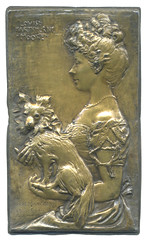 PORTRAIT OF LOUISE HARSHORNE MOORE, 1903. 113.2 68.8mm. Cast Bronze Thin Galvano. XF/AU. The portrait of Louise Hartshorne Moore is probably the most significant relief by Scudder in this grouping. The original marble bas-relief was exhibited at the Eighteenth Annual Exhibition of the Architectural League of New York in 1903 and illustrated in the catalogue.
PORTRAIT OF LOUISE HARSHORNE MOORE, 1903. 113.2 68.8mm. Cast Bronze Thin Galvano. XF/AU. The portrait of Louise Hartshorne Moore is probably the most significant relief by Scudder in this grouping. The original marble bas-relief was exhibited at the Eighteenth Annual Exhibition of the Architectural League of New York in 1903 and illustrated in the catalogue.Some contemporary sources state that this was one of two large medallions purchased by the French Government for the Musée de Luxembourg. Reductions were cast in bronze, silver and gold.
“Once, after one of his long twilight visits, I saw him [MacMonnies] bundling up several silver portrait medallions I had done in New York and brought to Paris with me. When asked what he was going to do with them he gave some evasive answer and left without satisfying my curiosity.
A week later he said casually: By the way those medallions of yours! I showed them to the curator of the Luxembourg Museum. He liked them so much he wants them for the museum. Would you mind giving them to the French Government?” Would I mind having my work in the Musée du Luxembourg the greatest honor any living artist can have! He might just as well have asked me if I wanted to go to heaven when I died. Nothing could possibly have given me so much inspiring encouragement.
To access the online catalog, see: Auction Seventy-Nine Featuring an Important Selection of American Medallic Art (www.maineantiquedigest.com/catalogs/presidentialcoinauction79.pdf)
NEW BOOK: THE QUARTERMASTER COLLECTION OF RARE AUSTRALIAN GOLD
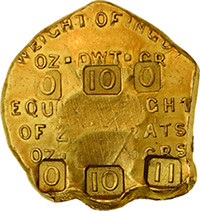 The famed Quartermaster Collection, containing many of Australia’s most valuable and highest quality gold coins, will be going to auction on the 4th of June 2009.
The famed Quartermaster Collection, containing many of Australia’s most valuable and highest quality gold coins, will be going to auction on the 4th of June 2009. Featuring many of Australia’s rarest coins, this Auction will be unlike any other seen in this country. The collection of 344 items is an anthology of Australian gold currency, spanning 1852 to 1931.
Some of the lots that will go under the hammer are unique or very few are known to exist, including:
- the excessively rare Adelaide Assay Office Ingots & Port Phillip Patterns,
- one of only two 1852 Five Pounds Coins, and
- the finest quality Type 1 & Type 2 Adelaide Pounds
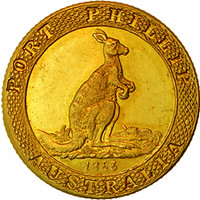
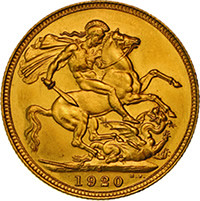
For Australia, these coins are an invaluable source of recollection for this young country’s economic independence. For many years, they have been the most impressive presentation of Australia’s first currency and are some of the most prized and historically significant pieces attainable for a quality numismatic portfolio.
The collection also features a complete set of Australian Sovereigns and Half Sovereigns, which contains more unique and excessively rare coins including:
- the 1853 Proof/Specimen Sovereign and Half Sovereign,
- the 1887 & 1902 Sydney Mint (5 Pound, 2 Pound, Sovereign & Half Sovereign) Proof Sets,
- Proof 1920 Sydney Mint Sovereign,
- Proof 1893 Melbourne Mint Half Sovereign,
- Several error coins, overdates and rare varieties
Every coin in the collection includes a record of provenance, which is an important element for many collectors of Antiquities.
To read the complete press release, see: Monetarium to Auction Australia’s Most Valuable Rare Gold Coin Collection (http://www.coinnews.net/2009/05/07/
monetarium-to-auction-australias-most-valuable-rare-gold-coin-collection/)
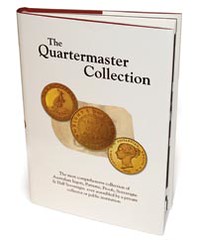 THE QUARTERMASTER COLLECTION. 2009. FULL COLOUR HARD BOUND BOOK. Limited edition of only 200 copies. The most comprehensive Collection of early Australian Coinage ever assembled. Featuring Adelaide Assay Office Ingots, Five Pounds & Pounds, Port Phillip Patterns, 1887S & 1902S Proof Sets, Complete Collection of Sovereigns & Half Sovereigns.
THE QUARTERMASTER COLLECTION. 2009. FULL COLOUR HARD BOUND BOOK. Limited edition of only 200 copies. The most comprehensive Collection of early Australian Coinage ever assembled. Featuring Adelaide Assay Office Ingots, Five Pounds & Pounds, Port Phillip Patterns, 1887S & 1902S Proof Sets, Complete Collection of Sovereigns & Half Sovereigns.For more information, see: www.monetarium.com.au/shop.asp?pid=7436
THE BOOK BAZARRE
MASSACHUSETTS HISTORICAL SOCIETY PUBLICATIONS NOW ONLINE
Anne E. Bentley writes:Collections of the Massachusetts Historical Society is a series devoted to publication of primary source materials from our library and others. Now in our 216th year of production.
Series 3, In 1832, James Mease reprinted his description of 17 colonial medals relating to Pennsylvania and most of the Comitia Americana set, and added descriptions of the 25 medals awarded by Congress in the War of 1812,
Collections vol. 76 is more familiar to you as Malcolm Storer’s Numismatics of Massachusetts.
Proceedings of the Massachusetts Historical Society is a series that covers 1791 through 1997, documenting meetings and papers presented through those years. Several notable articles appear here. William Sumner Appleton presented a paper on coins and medals relating to America in vol. 11 of the first series (1791-1883).
In series 2 he also reported on Dupré and his work for America in connection with the collection of his materials at the Boston Public Library (Proc. Ser. 2, v. 5). Series 2 also features Andrew McFarland Davis’s A search for a pamphlet by Governor Hutchinson (Proc. Ser. 2, Vol. 12) as part of his bibliography of pamphlets on paper money in provincial Massachusetts.
Shepard Pond’s paper on Pretenders to the French Throne in Numismatics appeared in Vol. 67. Our late Adams Papers Editor, Marc Friendlaender, published an entertaining account of Charles Francis Adams’s numismatic exploits in Charles Francis Adams, Numismatist, Brought to the Bar: Groux v. Adams in Vol. 86.
COLUMN: HARVEY STACK REMEMBERS
 Mike Hodder writes:
Mike Hodder writes: Named "Harvey Stack Remembers", it's always an interesting and enjoyable diversion. I recommend it to anyone who wants to read about the good old days when the coin business seems to have been fun and the characters in it larger than life.
To read Harvey Stack Remembers, see: www.stacks.com/harveystackremembers/
QUERY: SALATHIEL ELLIS PORTRAITS, CAMEOS SOUGHT
Dick Johnson writes:Does anyone have an illustration -- or the actual item -- of any cameo portraits he prepared over his career in the 1840s to 1860s? Georgia Chamberlain illustrated two of these in plaster and a separate illustration of Gilbert Stuart in her book, American Medals and Medallists. Are there any others?
Email me please: dick.johnson@snet.net
QUERY: NAME THE BIBLIOPHILE ON THIS FRANKLIN MINT MEDAL
Pete Smith writes: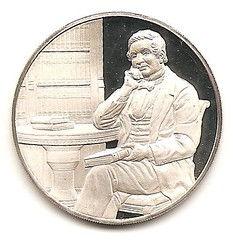 The item on Twilight Zone bibliophile Henry Bemis got a good response. Perhaps this item will generate some responses, too. Who is the book lover on the medal in the attached photo?
The item on Twilight Zone bibliophile Henry Bemis got a good response. Perhaps this item will generate some responses, too. Who is the book lover on the medal in the attached photo? Unfortunately, I don't know the answer. This is part of the Franklin Mint series on Postmasters and Stamps. This is number 17 issued on October 10, 1974. The person is not identified on the medal. I believe this came in an envelope with text. Once those are separated, it can be difficult to identify the person.
It is still a mystery to me. I will be interested the reaction of E-Sylum readers.
QUERY: JOHN J. FORD COLLECTION: SOLD AND UNSOLD
Karl Moulton writes:Other Ford collection items had been offered or sold previously beginning in 1983 when he sold his Hitler memorabilia. In 1990 & 1992, Ford consigned his 1852/1 USAOG "Proof" $20 to Superior. It failed to meet the reserve both times and was labeled as "Coiner John Kellogg's Personal Coin". Ford was not named as the consignor, but the same coin was sold in the Ford part II sale by Stack's, lot 363. In that offering, there was no mention of John G. Kellogg's prior ownership.
Other items were sold by Stack's in 1993 (slave hire badges & some Colonials). Other Ford Colonials (Connecticut) were offered in the June and September 1994 sales by Stack's. They list the consignor as the Ford Family Trust. Ford sold his Confederate States of America bonds in June of 1997 through Smythe at the Memphis show.
If there are other sales of Ford materials (especially foreign offerings) it would be nice to complete the list.
David Gladfelter writes:
We do know, from Q. David Bowers, that his Nova Constellation silver pattern set was sold privately circa 2005.
There are other UNSOLD segments of the collection; Alan V. Wienberg summarizes below the portions he's aware of. -Editor
- the finest collection of "Pseudo-Low" Hard Times tokens ever assembled, said by Steve Tanenbaum (who knew JJF well and is an expert in the HTT field) to surpass in value the original Low-listed Hard Times tokens auction by Stack's
- allegedly over 500 political ferrotypes, the largest group ever privately assembled
- an extensive collection of early Breton (listed & unlisted) Canadian tokens
- an extensive collection of Sutler tokens (and scrip?)
- an extensive collection of early American political tokens as listed (or unlisted) in DeWitt & Sullivan (and political ribbons?)
- an extensive collection of Western territorial, Indian and Post Trader tokens
Some of these segments had already been catalogued by Dr. George Fuld for Stack's but remain unsold.
MORE ON JOSEPH JENKS
Lou Jordan writes: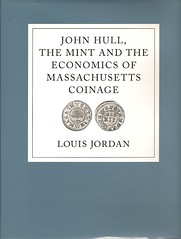 While there is no document directly linking Jenks to the mint‚ some suggestive evidence exists. A letter written in 1654 in London by John Hull’s brother‚ Edward Hull‚ to Joseph Jenks survives in which Edward Hull told Jenks he knew of a German die cutter willing to immigrate to Boston‚ but there is no evidence this person ever came to Massachusetts Bay (Morison‚ p. 152).
While there is no document directly linking Jenks to the mint‚ some suggestive evidence exists. A letter written in 1654 in London by John Hull’s brother‚ Edward Hull‚ to Joseph Jenks survives in which Edward Hull told Jenks he knew of a German die cutter willing to immigrate to Boston‚ but there is no evidence this person ever came to Massachusetts Bay (Morison‚ p. 152). However‚ if Jenks was making the tools or die blanks for the mint it would seem quite logical for him to pursue leads on a diecutter among his former acquaintances in the profession. That he was corresponding on this topic with Hull’s brother strongly suggests the request was made in relation to the recently opened mint. Jenks may have been pursuing a diecutter as a personal favor to John Hull‚ who was probably one of Jenks’s customers‚ or‚ if Jenks produced items for the mint‚ he may have been doing this as part of a business deal.
In addition to this letter from the early years of the mint‚ there is a document from the later period. In the proceedings of the Massachusetts Bay General Court there is a record from May 15‚ 1672‚ stating the Court denied a petition brought forward by Joseph Jenks in which he requested permission to be allowed to open a mint (Crosby‚ pp. 79-80). It is generally assumed Jenks would not have gone through the expense and trouble to submit a petition unless he knew the trade and felt he could have successfully competed with Hull.
With the demise of Hammersmith‚ Jenks seemed to have been searching for a new profession and felt he could be successful as a coiner. If Jenks had produced the steel die blanks or possibly some of the tools necessary for the continued operation of Hull’s mint he would certainly be in a position to enter the coining business. Based on his reputation as a master ironsmith and interpreting both his 1654 inquiry to Edward Hull about a diecutter and his unsuccessful 1672 petition in the manner stated above‚ it is probable Jenks made some items for the Hull mint.
Specifically what Jenks may have produced for the mint is entirely conjectural. Various metal objects are possible candidates such as wrought iron rollers to roll out the molded sterling strips and possibly metal tools such as crucibles‚ ladles‚ tongs and metal parts for the furnace. However‚ the items most frequently suggested are punches and die blanks. Punches would refer to sets of hardened punches used to impress the letter grouping NE on the obverse and another punch for the reverse used to impress the denomination in Roman numerals directly onto each of the NE coins.
Many long held assumptions concerning the minting and emission of colonial coins have been modified or overturned in the past few decades. Sometimes‚ as in the recent editions of R. S. Yeoman’s guide‚ popularly known as the Red Book‚ it is stated Jenks may have made the punches‚ without commenting on the dies.
Interestingly‚ Hartley‚ in his book on the Saugus Ironworks‚ mentions Jenks had been credited with making dies for the Pine Tree shillings as well as constructing the first fire engine‚ but he was suspicious of those claims (Hartley‚ p. 11).
MORE ON THE SCHULMAN-HOLZER COIN COLLECTORS' ALMANAC
Last week we discussed the late Hans Holzer and the book he collaborated with Hans Schulman on, the Coin Collectors' Almanac. I pictured green and red cloth copies and asked "Is anyone familiar with the different binding variants of this book?" George Kolbe writes: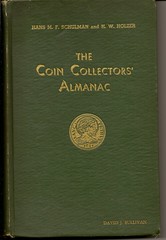
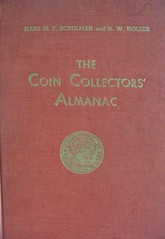
Schulman, Hans M. F. & Holzer, Hans. The Coin Collectors’ Almanac…With Contributions by Leading Experts. New York, 1946. (6), 372 pages, text illustrations. Original brown quarter baby calf, gilt. Near new.
Special Leatherbound Presentation Edition. F. C. C. Boyd stamped in gilt at the base of the upper cover; inscribed in blue ink on the front flyleaf: “To Mr. F. C. C. Boyd with many thanks for his friendship and interest. A very merry Xmas and a Happy New Year. Sincerely, Hans Schulman, New York, Xmas 1946.”
The only such example we have every encountered. Apparently published in a substantial trade edition, in several different colors of cloth, the work itself is an interesting if unusual general work, boasting an Editorial Board of Howard D. Gibbs, Frank J. Katen, Abe Kosoff, Robert I. Nesmith, and others, and reflective of the unique attributes of its authors. Living up to its title, it provides information on an amazing range of numismatic topics, and is still of interest today.
George Kolbe writes:
George Fuld adds:
The pedigree for this coin in the Ford sale was faulty as the origin for it from Waldo Newcomer is wrong as he never owned a plain edge Getz silver half dollar. It is discussed in the forth coming book on Getz issues due out in the coming months.
MORE ON CANADIAN ELONGATED CENTS
- 1. The machines use U.S. Cents that are pre-loaded into the machines
- 2. The machines use Copper planchets that are pre-loaded into the machines
In both cases, the user just puts in the cost of the coin, and the machine uses the pre-loaded Cent or planchet to smash the image on it. Just thought that the readers might be interested in knowing this. All the best & KEEP ON SMASHING!
AMAZON'S KINDLE E-BOOK READER GAINING FAST; NEW LARGE-SCREEN COMING
To read the complete article, see: Surpise! Amazon Launches Large-Screen Kindle (http://gigaom.com/2009/05/06/surprise-amazon-launches-large-screen-kindle/
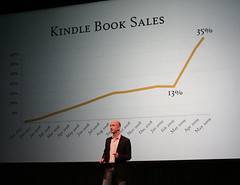 Amazon CEO Jeff Bezos dropped a bomb on the book industry while rolling out the big-screen Kindle this morning, Dan Frommer reports:
Amazon CEO Jeff Bezos dropped a bomb on the book industry while rolling out the big-screen Kindle this morning, Dan Frommer reports: To read the complete article, see: Kindle Books Now A Shocking 35% Of Sales When Kindle Version Available (http://www.businessinsider.com/henry-blodget-kindle-sales-now-a-shocking-35-of-book-sales-when-kindle-version-available-2009-5)
THE BOOK BAZARRE
MORE ON THE YOACHUM SILVER DOLLAR
Paul Bosco writes:I stumbled on an April 2008 E-Sylum reference to the Yoachum Dollar. As I bought the piece in the Hartzog auction, and subsequently sold it in my November 2000 auction, I am mentioned. It would have been better to quote my auction description.
I don’t have a 1984 Red Book at hand, to verify the quote –sheer hogwash-- supposedly pulled from it, in support of the existence of a Yoachum Dollar before the 1980s. It is not in later Red Books. As for the account of the restriking of the Yoachum Dollar, in an edge-marked edition of 142, I doubt this ever happened.
To read the earlier E-Sylum articles, see: QUERY: YOACHUM SILVER DOLLAR: APRIL FOOL? (www.coinbooks.org/esylum_v11n15a21.html)
COMMENTS ON THE YOACHUM DOLLAR (www.coinbooks.org/esylum_v11n16a12.html)
SOME HAUNTING BOOK-SCULPTURES
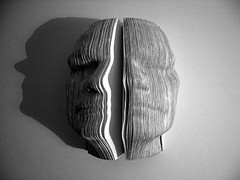 Artist Nicholas Galanin has created a wonderful collection of sculptures made from books, featuring reliefs of faces and traditional Tlingit forms.
Artist Nicholas Galanin has created a wonderful collection of sculptures made from books, featuring reliefs of faces and traditional Tlingit forms.To read the complete article, see: Haunting book-sculptures featuring Tlingit forms (www.boingboing.net/2009/05/06/haunting-book-sculpt.html)

QUEEN’S TRINITY CROSS MEDAL DEEMED UNLAWFUL
 An honour established by the Queen has been declared unlawful after Muslims and Hindus complained that its Christian name and cross insignia were offensive.
An honour established by the Queen has been declared unlawful after Muslims and Hindus complained that its Christian name and cross insignia were offensive. The Trinity Cross of the Order of Trinity was established by the Queen 40 years ago to recognise distinguished service and gallantry in the former colony of Trinidad and Tobago. It has been received by 62 people including the cricketers Garfield Sobers and Brian Lara, the novelist V. S. Naipaul and many of the islands’ leading politicians and diplomats.
The Privy Council in London has ruled that the decoration is unconstitutional because it discriminates against non-Christians.
The Trinity Cross was established in 1969 and took precedence over all other decorations except the Victoria Cross and George Cross. The title and choice of insignia followed six years of consultation and research of national awards in other countries. Questions were raised, though, about the overtly Christian nature of the words “Trinity” and “Cross” and the use of a cross insignia, which led to some of those nominated refusing to accept the decoration.
The law lords refused to make the order retrospective, meaning that the recipients will not be stripped of their honours.
Hugh Peskett, editor-in-chief of Burke’s Peerage and Gentry, said that changing the names of titles to remove their Christian references would destroy hundreds of years of history. “Part of the significance of an honour is its antiquity and I can see no reason why they should be changed,” he said.
To read the complete article, see: Queen’s Trinity Cross honour deemed unlawful by Privy Council (http://business.timesonline.co.uk/tol/business/law/article6245144.ece)
MORE ON THE REALISTIC VIETNAMESE PLAY MONEY
Regarding last week's item on the realistic-looking play money being sold in Viet Nam, Joe Boling writes: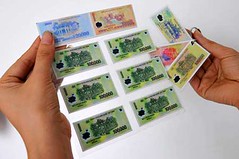 Tiny, high quality imitation bank notes intended for play, with ‘face values’ of between VND 10,000 and VND 500,000 are still displayed openly for sale though the State Bank of Vietnam has declared that the sale of the play money is illegal.
Tiny, high quality imitation bank notes intended for play, with ‘face values’ of between VND 10,000 and VND 500,000 are still displayed openly for sale though the State Bank of Vietnam has declared that the sale of the play money is illegal.Since local newspapers quoted officials as saying that the sale of play money copying real Vietnamese notes is illegal, big toy shops on Kim Ma and Luong Van Can streets in Hanoi no longer display the imitation bank notes. However, it’s still possible to purchase the play money in the ‘underground way’.
When reporters said they wanted to buy some play money, the owner of a shop on Kim Ma street said that she could give the ‘money’ straight away if only a small volume was needed. However, to obtain a lot of ‘money,’ the reporters would have to return the next day, she said. “As the sale of play money is prohibited, we dare not keep it in big quantity,” she said.
Meanwhile, on small alleys near elementary schools like Quan Tho, Nguyen Khang and Nui Truc, the imitation bank notes are on open sale.
Most of the imitation bank notes are only one-quarter of the size of a real bank note. However, the imitation bank notes have the colour and print quality of real bank notes.
A toy shop owner on Nui Truc street said the imitation money has been imported from China.
The ‘banknotes’ made of different materials. Some, made of cotton paper, are the size of matchboxes, and have face values of 5,000, 10,000, 100,000 and 200,000 dong. Children like the money because the bank notes are colourful and look like real money.
The sale prices of toy bank notes do not depend on the ‘face value’ of the money, but on the material of the ‘bank notes’. The cotton ‘bank notes’ are selling at 200 dong per sheet of A4 paper, while plasticized ‘bank notes’ are more expensive, 1,000 dong per sheet.
In fact, not only children, are buying the play money, but adults as well, who purchase the money for souvenirs or collections.
According to an expert, the play money has been printed with offset technology that allows to very accurate reproduction.
To read the complete article, see: Real-looking play money still on sale in Hanoi (http://english.vietnamnet.vn/biz/2009/05/846008/)
TREASURY DEPARTMENT ISSUES RECALL OF ALL US DOLLARS
Loren Gatch writes:To read the complete article, see: Treasury Department issues recall of all us dollars (www.theonion.com/content/video/treasury_department_issues)
FEATURED WEB SITE: WORLDCAT
This week's Featured Web Site is suggested by Joseph D. McCarthy. WorldCat is a site for locating books in libraries worldwide.www.worldcat.org
